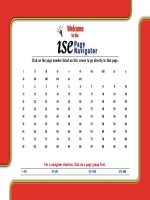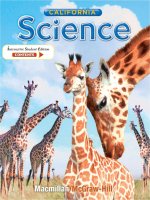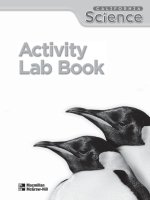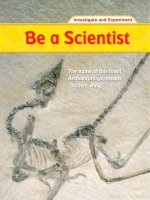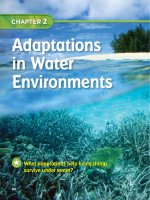- Trang chủ >>
- THPT Quốc Gia >>
- Hóa
California science grade 5 (1)
Bạn đang xem bản rút gọn của tài liệu. Xem và tải ngay bản đầy đủ của tài liệu tại đây (4.43 MB, 255 trang )
All photographs are by Macmillan/McGraw-Hill (MMH) except as noted below.
Cover Photos: Gary Bell/oceanwideimages.com.
Science Content Standards for California Public Schools reproduced by permission, California Department of Education, CDE
Press, 1430 N Street, Suite 3207, Sacramento, CA 95814.
Published by Macmillan/McGraw-Hill, of McGraw-Hill Education, a division of The McGraw-Hill Companies, Inc.,
Two Penn Plaza, New York, New York 10121.
Copyright © by Macmillan/McGraw-Hill. All rights reserved. No part of this publication may be reproduced
or distributed in any form or by any means, or stored in a database or retrieval system, without the prior written consent
of The McGraw-Hill Companies, Inc., including, but not limited to, network storage or transmission, or broadcast for
distance learning.
Printed in the United States of America
1 2 3 4 5 6 7 8 9 005 09 08 07 06
A
Contents
LIFE SCIENCE
Chapter 1
Structure of Living Things . . . . . . . . . . . . . . . . . . . . . . . . . . . . . 1
Chapter 2
Plant Structures and Functions . . . . . . . . . . . . . . . . . . . . . . . . 21
Chapter 3
Human Body Systems . . . . . . . . . . . . . . . . . . . . . . . . . . . . . . . . 41
EARTH SCIENCE
Chapter 4
Earth’s Water . . . . . . . . . . . . . . . . . . . . . . . . . . . . . . . . . . . . . . . 69
Chapter 5
Earth’s Weather . . . . . . . . . . . . . . . . . . . . . . . . . . . . . . . . . . . . . 93
Chapter 6
The Solar System . . . . . . . . . . . . . . . . . . . . . . . . . . . . . . . . . . . 125
PHYSICAL SCIENCE
Chapter 7
Types of Matter . . . . . . . . . . . . . . . . . . . . . . . . . . . . . . . . . . . . 145
Chapter 8
Changes in Matter . . . . . . . . . . . . . . . . . . . . . . . . . . . . . . . . . . 177
Everyday Science Activities . . . . . . . . . . . . . . . . . . . . . . . . . . . . . . . . . . . . . 197
© Macmillan/McGraw-Hill
Learning Labs . . . . . . . . . . . . . . . . . . . . . . . . . . . . . . . . . . . . . . . . . . . . . . . . .229
California science standards are noted at the top of activity pages. For the text of the
standards, please refer to the Reference section of the California Science Student Edition.
Activity Lab Book
iii
Name
Date
What are plants and
animals made of?
Explore
California Standard
5 IE 6.i.
Materials
Make a Prediction
Animals and plants are living things. Think
about the differences between plants and
animals. Do you think these differences mean
that the parts that they are made of are similar or
different?
• microscope
• prepared slides of
leaf cells
• prepared slides of
blood cells
Test Your Prediction
Observe Look at the prepared slide of a leaf under the microscope.
For help using the microscope, ask your teacher and look at page
461.
© Macmillan / McGraw-Hill
Record Data Draw what you see.
!
Observe Look at the prepared slide of blood under the microscope.
"
Record Data Draw what you see.
Chapter 1 • Structure of Living Things
Activity Lab Book
Use with Lesson 1
Cells
1
Explore
Name
Date
Draw Conclusions
#
Compare How were the plant leaf slide and animal blood slide alike?
How were they different?
$
Communicate Write a report explaining whether or not your
observations supported your prediction.
© Macmillan / McGraw-Hill
Explore More
Examine the drawings you made and think about the living things they
came from. Do you think that a leaf from another plant would look the
same? Make a prediction and plan an experiment to test it.
2
Chapter 1 • Structure of Living Things
Activity Lab Book
Use with Lesson 1
Cells
Name
Date
Alternative
Explore
How are plant and animal
cells different?
Cell Identification
Plant and animal cells have similarities and
differences. Look at the images labeled plant
cells and animal cells.
Materials
• one labeled image
of a plant cell
• one labeled image
of an animal cell
© Macmillan / McGraw-Hill
With your partner, discuss similarities and
differences in the cells. Record what you notice.
Chapter 1 • Structure of Living Things
Activity Lab Book
Use with Lesson 1
Cells
3
Quick Lab
Name
Date
Plant and Animal Cells
Make a Model Put one plastic bag in the
storage container. This is your plant cell.
The other plastic bag is your animal cell.
Using a spoon, carefully put gelatin in
both bags until the bags are almost full.
Materials
• two sandwich
bags
• one sandwich
container with lid
!
Pick the vegetables that look the most
like the plant and animal organelles.
"
Place the vegetables that you have picked
into the appropriate container and seal the
bags.
• pencil (optional)
#
Compare Try to stack your models. How
well do the plant cells stack compared to
the animal cells?
• vegetables
$
Communicate Discuss with your classmates which vegetables you
selected for your organelles and explain why.
• masking tape
(optional)
• gelatin
© Macmillan / McGraw-Hill
• spoon
4
Chapter 1 • Structure of Living Things
Activity Lab Book
Use with Lesson 1
Cells
Name
Experiment
Date
Focus on
Inquiry Skills
California Standard
5 IE 6.f., 5 IE 6.c.
All living things are made up of cells. Every cell has a cell membrane, or a
layer around the outside of the cell. A cell membrane acts like the door to
the cell. It lets things in and out of the cell. One way to learn more about
how cell membranes work is by doing an experiment.
Learn It
An experiment is a test that supports or disproves a hypothesis. To
carry out a successful experiment you need to perform a test that
examines the effects of one variable on another using controlled
conditions. You can then use your data to draw a conclusion about
whether or not the hypothesis has been supported.
© Macmillan / McGraw-Hill
In the following experiment, you will test the effects of variables on a
cell membrane. Using vinegar, you will dissolve the shells of two eggs
to expose the egg membranes. Then you will gather and analyze data
to support or disprove the following hypothesis: If the liquid outside
a membrane is thicker than the liquid inside the membrane, then the
liquid inside the membrane will move out to balance the concentration.
Chapter 1 • Structure of Living Things
Activity Lab Book
Use with Lesson 1
Cells
5
Focus on
Name
Inquiry Skills
Date
▲
Try It
Pour 200 mL of vinegar into two jars
with lids and carefully lower two eggs
into the jars of vinegar. Tighten the
lids and leave the eggs inside for one
day.
▲
Use a spoon to carefully remove the
eggs and rinse them under water.
▲
Measure each egg using either the
measuring tape, metric measuring cup,
or balance. Record the measurements
in the chart below.
Materials
• an uncooked egg
• 2 jars with lids
• 200 mL of white
vinegar
• 200 mL of water
• 200 mL of corn
syrup
• measuring tape
▲
Use a spoon to carefully remove the
eggs and rinse them under water.
• spoon
▲
▲
Pour 200 mL of water into a beaker
and 200 mL of corn syrup into another
beaker. Carefully lower an egg into
each beaker. Leave the eggs inside
for one day.
Measure the eggs again using the same
measuring tool you used earlier. Record the
measurements in the chart below.
Measurement Tool
Used
Initial Measurement
• balance
• metric measuring
cup
Final Measurement
Egg in water
6
Chapter 1 • Structure of Living Things
Activity Lab Book
© Macmillan / McGraw-Hill
Egg in corn
syrup
Use with Lesson 1
Cells
Name
Focus on
Inquiry Skills
Apply It
Now it is time to analyze your data and observations. Use your chart
to compare your initial and final measurements of the eggs.
▲
Did both eggs change in size? Did one change more than
the other?
▲
Why do you think this happened? Does this support or disprove the
hypothesis?
© Macmillan / McGraw-Hill
!
Date
Chapter 1 • Structure of Living Things
Activity Lab Book
Use with Lesson 1
Cells
7
Focus on
Name
Inquiry Skills
Date
© Macmillan / McGraw-Hill
Use this page for any notes you have about the experiment.
8
Chapter 1 • Structure of Living Things
Activity Lab Book
Use with Lesson 1
Cells
Name
Date
What are the levels of
organization of living things?
Explore
California Standard
5 IE 6.g.
Materials
Purpose
To research the levels of organization of an onion
plant.
• gloves
Procedure
• onion
Peel the skin of an onion.
• goggles
• slides
• water
© Macmillan / McGraw-Hill
Make a wet-mount slide by placing a small
piece of onion skin in the center of the slide,
then put a drop of water on the onion skin.
Carefully put a cover slip on top.
!
Observe View the onion skin under
low power. What do the cells look like?
Draw what you see.
"
Observe Use the hand lens to observe
another piece of onion skin.
Draw what you see.
#
Take the remaining onion and remove
all of its parts. Make a diagram of the
structure of the onion.
Chapter 1 • Structure of Living Things
Activity Lab Book
• microscope
• hand lens
Use with Lesson 2
From Cells to Organisms
9
Explore
Name
Date
Draw Conclusions
$
Compare Are the various onion cells you observed in the onion layer
similar or different?
%
Infer How do these cells work together?
© Macmillan / McGraw-Hill
Explore More
Research the levels of organization of the onion plant. Answer these
questions with a labeled diagram. What is an onion? Is it part of the roots
or the stem?
10
Chapter 1 • Structure of Living Things
Activity Lab Book
Use with Lesson 2
From Cells to Organisms
Name
Date
Alternative
Explore
Model Cell Structure
Record Data Draw and label the parts of
the vegetable you are examining.
Materials
• radish with roots
and leaves
• carrot with roots
and leaves
• parsnip with roots
and leaves
• hand lens
Use a hand lens to search for different cells
in a slice of your vegetable.
Record what you see as you examine the parts of the vegetable.
© Macmillan / McGraw-Hill
!
Chapter 1 • Structure of Living Things
Activity Lab Book
Use with Lesson 2
From Cells to Organisms
11
Quick Lab
Name
Date
Muscle Tissues
Make a Model Tie a piece of yarn
between two chairs. Have two
classmates sit on each chair. This yarn
represents one cell in your muscle tissue.
Materials
• two chairs
• metal ruler
Using a metal ruler, twist the yarn until it
snaps.
• yarn
Now tie two pieces of yarn to the chairs.
Try to break the yarn again.
"
Repeat this experiment until you have enough pieces of yarn that the
twisting cannot break it.
#
How does this model show how muscle cells work in your body?
$
Infer Are your muscles stronger when cells work together?
© Macmillan / McGraw-Hill
!
12
Chapter 1 • Structure of Living Things
Activity Lab Book
Use with Lesson 2
From Cells to Organisms
Name
Date
Inquiry: Structured
How do cells from different
tissues in the human
body compare?
Be a
Scientist
California Standard
5 IE 6.b., 5 IE 6.c.
Materials
• microscope
• muscle slide
Form a Hypothesis
• skin slide
A cell can be an organism that carries out its
• nerve slide
own life processes. Bacteria and protists are
unicellular organisms. A cell can also be a part
• colored pencils
of a multicellular organism. Cells in multicellular
organisms might have a single, very specific,
function. For example, a cell in the stomach
might only be responsible for producing one digestive chemical.
Do you think cells from different tissues in the human body have different
forms? Are all cells from the human body alike or different? Write your
answer as a hypothesis in the form “If cells belong to different tissues in the
human body, then . . .”
Test Your Hypothesis
© Macmillan / McGraw-Hill
Experiment Place the muscle slide on the microscope stage.
Follow your teacher’s instructions to focus the microscope.
Be Careful. Tell your teacher immediately if a slide breaks.
Observe Use colored pencils and draw
the image you see in your journal. Label
your drawing.
Chapter 1 • Structure of Living Things
Activity Lab Book
Use with Lesson 2
From Cells to Organisms
13
Be a
Scientist
!
Name
Date
Experiment Repeat steps 1 and 2 with the skin and nerve slides.
Draw Conclusions
Communicate Describe the cell size and shape for each cell type.
Compare What similarities and differences did you see?
Did the experiment support or disprove your hypothesis? Explain you
answer.
© Macmillan / McGraw-Hill
!
14
Chapter 1 • Structure of Living Things
Activity Lab Book
Use with Lesson 2
From Cells to Organisms
Name
Date
Be a
Scientist
Inquiry: Guided
How do cells from different
plant tissues compare?
Form a Hypothesis
You have already learned about the differences between animal and plant
cells. You also know that, like animals, plants are made up of cells that form
tissues. Do you think cells from different tissues in a plant have different
forms? Write your answer as a hypothesis in the form “If cells belong to
different tissues in a plant, then . . .”
▲
My Materials and Resources:
▲
The Steps I Will Follow:
▲
© Macmillan / McGraw-Hill
Test Your Hypothesis
Design a plan to test your hypothesis. Then write out the materials,
resources, and steps you need. Record your results and observations as
you follow your plan and conduct your experiment.
These Are My Results:
Chapter 1 • Structure of Living Things
Activity Lab Book
Use with Lesson 2
From Cells to Organisms
15
Be a
Scientist
Name
Date
Draw Conclusions
Did your experiment support your hypothesis? Why or why not?
Inquiry: Open
What else can you learn about cells and tissues in plants and animals? For
example, how many types of tissues do we have? Determine the steps you
will follow to answer your question. Record and document the resources
you use throughout your investigation.
My Question Is:
How Can I Test It:
My Results Are:
© Macmillan / McGraw-Hill
!
16
Chapter 1 • Structure of Living Things
Activity Lab Book
Use with Lesson 2
From Cells to Organisms
Name
Date
Explore
California Standard
5 IE 6.a.
How would you classify
a new plant?
Purpose
You are part of an expedition that is studying
plants in the jungle. You find a plant you’ve
never seen before. How do you classify it? You
could use a classification key. A classification key
lists traits of organisms. It gives directions that
lead you to the organisms’ identities. Use this
classification key to classify plants.
Observe Choose a plant and examine its
structures with the hand lens.
Use the classification key to
identify your plant. Start with the
first pair of traits and choose the
trait that applies to your plant.
!
Repeat steps 1 and 2 for the other
four plants.
Plant 1:
Plant 2:
Plant 3:
• water plant, such
as an elodea
• flowering
plant, such as a
geranium
• small pine or
other conifer
• moss plant
Procedure
Materials
• fern plant
• hand lens
Classification Key for Plants
1. Stem . . . . . . . . . . . . . . . . . . . Go to 2
No stem . . . . . . . . . . . . . . . . . . Moss
2. Produces flowers . . . . . . Geranium
No flowers. . . . . . . . . . . . . . Go to 3
3. Waxy leaves . . . . . . . . . . . . Conifer
Non-waxy leaves . . . . . . . . Go to 4
4. Grows in soil . . . . . . . . . . . . . . . Fern
Grows in water . . . . . . . . . . .Elodea
© Macmillan / McGraw-Hill
Plant 4:
Plant 5:
Chapter 1 • Structure of Living Things
Activity Lab Book
Use with Lesson 3
Diversity of Organisms
17
Explore
Name
Date
Draw Conclusions
"
Why do you think classifying organisms helps scientists? Explain.
#
Infer Which of the plants you classified are more similar, or more
closely related, to each other? Explain.
© Macmillan / McGraw-Hill
Explore More
What traits could you use to identify other organisms, such as birds?
Research another group of organisms and create a classification key for
them. Your key should begin with general traits and end with traits that are
more specific.
18
Chapter 1 • Structure of Living Things
Activity Lab Book
Use with Lesson 3
Diversity of Organisms
Name
Date
Alternative
Explore
Classifying Flowers
Observe Look at the bouquet. What
similarities and differences do you notice
about the flowers?
Record Data Make a chart like the one
below to record your observations.
Similarities
• bouquet of mixed
flowers or a
photo of a mixed
bouquet
Differences
Communicate Share your observations with the class.
© Macmillan / McGraw-Hill
!
Materials
Chapter 1 • Structure of Living Things
Activity Lab Book
Use with Lesson 3
Diversity of Organisms
19
Quick Lab
Name
Date
Bread Mold Activity
Trace the outline of a slice of bread on
graph paper.
Put a drop of water on one corner edge
of the bread and put it in a bag. Place the
bag in a warm, dark corner.
!
"
Observe On the first day you see mold,
sketch the shape of the moldy area on your
graph paper.
For the next three days, use a different color
to sketch the next growth.
Materials
• bread
• paper
• sealable sandwich
bag
• water
• colored pencils
• centimeter ruler
• dropper
Record Data Count the number of squares
that were covered with mold each day.
$
Create a graph to show the growth of the mold each day.
© Macmillan / McGraw-Hill
#
20
Chapter 1 • Structure of Living Things
Activity Lab Book
Use with Lesson 3
Diversity of Organisms
Name
Date
Explore
What are the parts of
vascular plants?
California Standard
5 IE 6.g.
Purpose
You have learned that all vascular plants have
vessels in their stems. What else do vascular
plants have in common? You will examine several
vascular plants to find out.
• cactus plant
Procedure
• disposable plates
Examine each plant. Look at the roots, stems,
and leaves.
Materials
• water plant
• flowering plant
• gloves
Record Data Make a chart for each plant.
Draw what the plant’s root, stem, and leaves look like.
Record the color, size, and shape of each plant part.
Compare Which of the plant parts look similar? Which parts look
different?
© Macmillan / McGraw-Hill
!
Chapter 2 • Plant Structures and Functions
Activity Lab Book
Use with Lesson 1
Vascular Plants
21
Explore
Name
Date
Draw Conclusions
"
How do the stems of the water plant and the cactus compare? Why
do they have these differences?
#
Infer Would the flowering plant be able to survive in a hot, dry area?
Why or why not?
$
Infer Would the water plant be able to survive out of the water?
Why or why not?
© Macmillan / McGraw-Hill
Explore More
Look at the plants where you live. Observe three plants and compare them
to these three plants. Based on your observations, decide if each of the
plants you observed are also vascular plants.
22
Chapter 2 • Plant Structures and Functions
Activity Lab Book
Use with Lesson 1
Vascular Plants

